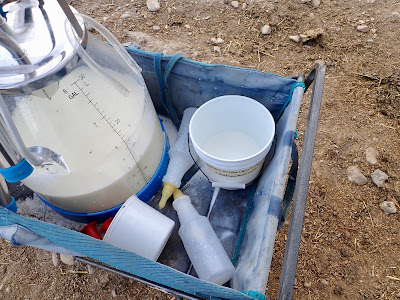 |
| She is gentle and sweet and likes people. She'll be perfect for the visitors that come to the farm. |
She's so cute and little! Almost like a cute stuffed animal!
The little lamb doesn't have a name yet. I've got a contest going at facebook to see what names my friends can come up with. If you have a good idea put it in the comments below!
 |
| I haven't picked up this 2 week old bull calf yet. This is his photo from KSL Classifieds. |
I'll be picking him up tomorrow and letting you know more about him next week. I love spring when we have babies on the farm!
He should fit in well with the other animals. The owners said he is friendly and loves to drink a bottle. He plays with the goats on their farm, too.
The animals are all happy it's spring, too. The pasture is growing and that is so much tastier than dry hay.
The kid goats are still here. They will be going to their new home in a few weeks. A barn burned down, and the new family is helping care for the animals that were injured.
One thing I really appreciate about most hobby farmers and small livestock owners is that we help each other out whenever we can. It's like a big family. We take care of our own, but we are always willing to help when an emergency comes up.
 |
| The garden is coming along slowly. The girl across the street is helping fill the beds with dirt. I teach her guitar, and she works off her lessons. |
 |
| We are using some car ramps for the wheelbarrow to run up. We can dump the dirt right into the bed without damaging the sides of the raised beds. |
 |
| Some of the seeds are sprouting. They are a little slow this year because I have them out in the mud room instead of the basement where it's warmer. |
 |
| I bought a few tomato plants, too. I usually buy bigger tomato plants, but this year I decided to see if the smaller plants would adjust better after planting in the garden. |
I'll be using old 5 gallon buckets as protection for the tomatoes this year. My friend likes them so much better than using the water filled garden tee pees that most people like to use. I don't like the water tee pees much because they are hard to keep filled, and if we have a wind storm they blow over on the plant.
* * * * *
Warning: dog injury photos below!
Mishka, the puppy who just turned 1 year old this month, likes to play.
She likes to play even when the other dogs are done playing.
She can get a little annoying, just like a little sister picks on a big sister or brother.
Then someone gets hurt.
We thought we had treated her wound, but we missed some of it. When we found the infection we had to trim all the fur away, drain the infection, and clean it with saline solution (the stuff people use for the contacts).
 |
| This is what it looked like right after we finished. |
Bryon and Heather have been working on a skin cream with CBD for pain for about 2 years. They are scientists so they had access to it before most people did.
We have found that it does a great job healing! They even have a patent pending on it.
 |
| And this is what it looks like 5 days later. It looks a little gooby because we just put more cream on it. |
Why is it called The Doctors? Because both Bryon and Heather have PhD's. Bryon has a PhD in Organic Chemistry, and Heather has a PhD in Biochemistry.
They make a great team!
They are two people that really 'think they can' and they are right! They know it can be hard work, but they also know they can do whatever they put their mind to!






















































